
Originally published in The Clarinet 51/1 (December 2023).
Printed copies of The Clarinet are available for ICA members.
2022 ICA Research Competition Winner
MPINGO:
A CLOSER LOOK
The wood most commonly used to make clarinets has a complex history, unique biology, and cultural significance. Jessica Bell provides a closer look at mpingo, drawing on published sources as well as her personal experience in Tanzania.
by Jessica Bell
This paper provides a comprehensive review of the wood most commonly used to make clarinets, Dalbergia melanoxylon (mpingo). Traditionally, mpingo has been used for medicinal purposes, wood carvings and even for building the structure of houses. According to A.B. Cunningham, D. melanoxylon has been traded for over 4400 years and was one of the first things ever traded in ancient Egypt.1 This paper is intended to provide a different perspective on mpingo, one that sheds light on the communities surrounding it and, in a way, displays the “social life of mpingo.”2 Within this exploration, we navigate the nuanced intersection where the cultural significance of the wood converges with its role in shaping the musical essence of the clarinet.
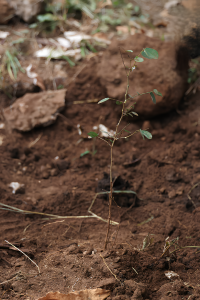
Mpingo seedling
Acoustical Properties
Although craftsmanship is a huge factor in acoustics of an instrument, material choice is just as important, playing a vital role in determining the instrument’s tone, projection, and response. On the clarinet, sound is produced by the air column resonating through the body of the horn, and much of the sound quality is “determined by the interaction of the material with the enclosed column of vibrating air.”3 According to U.G. Wegst, “The acoustical properties of wood, such as the volume, quality, and color of the sound are determined by the mechanical properties of the material from which they are made because the sound is produced by vibrations of the material itself.”4 The relevant acoustical properties regarding materials for instrument making are: the speed of sound within the material ; the characteristic impedance ; the sound radiation coefficient ; and the loss coefficient . While material of choice has a major role in clarinet acoustics, factors like reed/mouthpiece choice, bore/tone hole shape, and player skill also play a significant role in shaping the instrument’s sound.
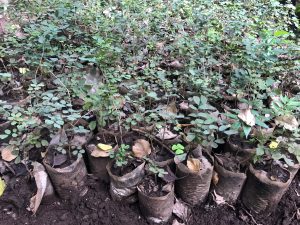
Mpingo seedlings
Materials for Clarinet Manufacturing
The clarinet has been made from many materials, from metal to carbon fiber. Instrument makers and players generally prefer organic materials over the many alternative synthetic materials available. Mpingo is now the most common choice of wood for clarinet, but during the 18th century, clarinets were usually made of European boxwood; occasionally makers makers used ivory, maple, fruit wood, pear, and brass.5 African blackwood began to be the wood of choice in the mid-19th century. Table 1 lists the types of woods that have been notably used for clarinet production.
Table 1: Types of woods used for clarinet production:
| Wood Species | Common Name | Characteristics | Geographic Origin |
| Diospyros melanoxylon | Ebony | Native to East India and Sri Lanka, used in the past for clarinets and mouthpieces, hard and durable, grows around 25m with a 1.9m girth, requires light, drought and frost hardy, sensitive to waterlogging, found in dry deciduous forests. | East India and Sri Lanka |
| Byra ebanus | Jamaican Rain Tree or Cocus | Dark brown tropical hardwood from the West Indies, grows to about 9.14m, has droopy branches, blooms after rain, popular in the 19th and early 20th centuries, occasionally used today for mouthpieces, generally straight grains. | West Indies |
| Dalbergia retusa | Cocobolo | Dense hardwood from Central America, reaches a height of 14-18m, red-brown color with orange and yellow shades, fairly straight, fine texture, high oil content can pose gluing challenges, used by some clarinet manufacturers as an alternative to mpingo, listed on CITES Appendix II. | Central America |
| Buxus sempervirens | Boxwood | Wood used for baroque clarinets, yellow color, 3-8m in height, fine, straight texture, prone to cracking, neutral tones, easy to grow but susceptible to fungal infections causing dark streaks and insect attacks. | Various regions, commonly found in Europe |
| Dalbergia nigra | Brazilian Rosewood | Chocolate brown to reddish-brown or purplish color, similar qualities to mpingo as both are in the Dalbergia genus, uniform medium-sized grains, resistant to insects, very durable, easy to work with, listed on CITES Appendix I due to the risk of economic extinction for the entire Dalbergia genus. | Brazil |
| Dalbergia melanoxylon | Mpingo | Most common wood for clarinet manufacturing, typically 4-10m, bush-like if not pruned, heartwood takes 70-100 years to mature for use in instrument manufacturing. | East Africa (Tanzania, Mozambique) |
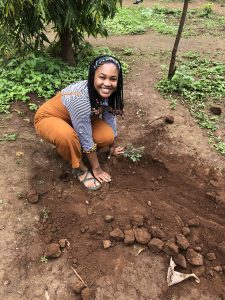
Jessica Bell planting a mpingo seedling
Biological Analysis of Mpingo
Dalbergia melanoxylon, commonly known as African blackwood or mpingo, is a highly valued timber species with a rich history of cultural, ecological, and economic importance. It has been renowned for centuries for its dense, dark wood and exceptional tonal properties, making it highly sought after for musical instruments, especially clarinets. By understanding this species, we can foster sustainable management practices and promote its conservation in the face of increasing demand and habitat pressures.
Mpingo belongs to the Dalbergia genus, which is classified as rosewood, and furthermore to the Fabaceae family, categorized as legumes. Mpingo can grow between 4-10 meters, occasionally growing up to 20 meters. Growth time is an important factor in the sustainability of mpingo harvesting. Mpingo takes approximately 70-100 years to fully mature to a size usable for the production of musical instruments.6 This length of time is required for the heartwood to chemically change to the dark color known and loved by clarinetists, and for the tree to develop in height, circumference, and overall strength.
The process of turning the heartwood black includes physiological processes within the tree and the accumulation of specific substances. One of the key chemicals in mpingo is melanin. The word “melanin” refers to a group of high molecular weight black and brown pigments formed through the oxidation and polymerization of phenolic compounds.7 This induces the browning or darkening process. Although this is how melanin works generally in plants, the exact enzymes and mechanisms involved in the enzymatic oxidation of phenolic compounds in mpingo are not fully understood. The color of mpingo can vary from dark brown to purple to black. When grown closer to the sea, the heartwood is a lighter brown and growth rings are visible. Inland trees are said to have a darker color and more durability. The darker the wood, the slower the tree grows.8 Mpingo grows in sub-Saharan regions across Africa but is concentrated in Tanzania and Mozambique.
Mpingo is a unique tree in that it has a vast root system and can virtually grow in any type of soil. It is important to consider the vast root system when replanting. Seedlings should be planted at least 3 meters apart to account for root growth. The mpingo root system contains bacteria that fertilizes the soil and neighboring plants through nitrogen fixation. Mpingo is a light-demanding tree. This is important to the process of producing the melanin needed for its signature pigment.9 Visually the trunk is relatively small, and cylinder shaped. The bark is a light brown, ashy color. The branches have large thorns with leaves that resemble a feather. Mpingo produces small, unobtrusive flowers that are typically white or pale yellow in color. The tree usually blooms during the dry season, with flowering occurring from September to November. Mpingo bears green fruit pods that turn brown/black as they ripen.10 Pruning is an important part of the replanting process. If mpingo is not properly pruned, it will turn bush-like, which does not make for quality instruments.
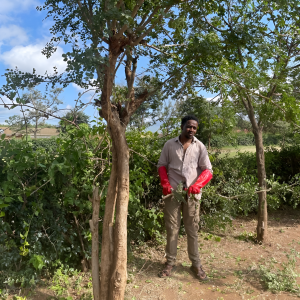
Makumira University music student Emmanuel Zshuaka pruning mpingo trees in Moshi, Tanzania, as part of his work with Daraja Music Initiative
Working Conditions
Once harvested, the mpingo logs undergo careful extraction and transportation to processing facilities, minimizing damage to the wood. The logs are typically subjected to a period of aging and drying, allowing the wood to stabilize and reach an optimal moisture content for further processing. The mpingo logs are cut into rough blanks, which serve as the initial raw material for clarinet production. Once the wood is extracted, dried, and milled to usable billets, it is then transported to a major clarinet manufacturer. Once the billets arrive to these manufactures, the wood has another drying period, is turned, and the bore is drilled. Tone holes and tenons are added and the instrument is sent to finishing. Here, sanding and key fitting take place. The new clarinet is then sent to inspection and testing to ensure it is ready for the market.
This process is simple in theory, however the harvesting of mpingo poses significant challenges and raises concerns regarding working conditions for the individuals involved in the process.11 The extraction process involves labor-intensive work, low wages, safety hazards, and inadequate regulations. Mpingo harvesting is a very skilled profession. Harvesters must successfully identify mature trees suitable for clarinet production, carefully fell, and finally extract the heartwood. This process often takes place in remote and economically disadvantaged areas, resulting in unique challenges for the workers involved. Just for comparison, mpingo is one of the hardest woods in the world, almost as hard as steel, often dulling the steel used to cut before the job is done.12 There are many hazards faced when harvesting mpingo. Heavy lifting, working with sharp tools, and harsh weather are just a few of the risks that can lead to injuries and long-term health issues. Many of these harvesters work with informal labor agreements lacking fair wages, social security benefits, and legal protections. The absence of formal employment contracts exacerbates their vulnerability and contributes to economic inequality. These issues lead to bigger problems like illegal harvesting.13 Mpingo harvesters often work in remote areas with limited access to healthcare facilities, clean water, and education. This further compromises their wellbeing and perpetuates socio-economic disparities.
Mpingo in Africa
Mpingo use dates back to ancient Egypt. In her article “A 5,000 Year History of the International Trade In Dalbergia Melanoxylon,” Bette Stockbauer-Harris details the many uses and implications of the wood in ancient Egyptian societies.14 D. melanoxylon, known as hnby (ebony) during the time, was held as a highly valued import similar to ivory and gold. During the time it was used for thrones, tablets, building materials like dovetail cramps, walking sticks, and the “ebony harp,” to name a few.15 In modern times mpingo became less available across Africa and more concentrated along the east coast in Tanzania and Mozambique.
Colonialism
In the late 19th century, European colonial presence in East Africa, driven by powers like Britain, Germany, and Portugal, began with the scramble for Africa. This period witnessed the exploitation of people, in the form of forced labor, and the region’s resources, including ivory, gold, silver, diamonds, and valuable hardwood such as mpingo. The coastal areas, historically influenced by Arab and Persian traders, became key points for formal colonization and trade ports. This colonial expansion had profound impacts on local populations and ecosystems, as European nations sought to procure valuable commodities and establish lucrative trade networks in East Africa in countries such as Kenya, Tanzania, Mozambique, and Uganda.16
Correlations Between Mpingo Harvesting for Musical Instruments and the Ivory Trade
The disparities among mpingo trade correlate with the ivory trade. One of the most notable towns involved with ivory trade is Ivoryton in colonial Connecticut created by Samuel Merritt Comstock. He, along with George Read and the Pratt Brothers, created a thriving village that would soon be known for ivory combs, piano key making, and ship making.17 Their main source of ivory was Zanzibar. Zanzibar is a small island off the east coast of Tanzania. Tippo Tib was known as the ivory czar in Tanzania and facilitated much of the trade and labor between Arab and Western nations.18 During the 19th century, the Royal Navy’s antislavery patrols were more active on the west coast of Africa. This opened slave trade opportunities along the east coast of Africa, shifting the ivory trade and subsequently mpingo trade to east Africa by the mid-19th century.19 During this time piano keys could be partially constructed from ivory or mpingo. This historical timeline, mirroring the intricate paths of the ivory and blackwood trade, underscores the far-reaching impact of trade on craftsmanship and ecosystems:
A great price was paid by humans and elephants alike. The great explorer Henry M. Stanley said that each elephant tusk that was brought back to the coast cost at least one human life en route. Upon reaching the end of the trail in Zanzibar, those men and women still surviving were usually sold into slavery for Middle Eastern and Asian markets.20
Ivoryton’s legacy echoes the dual nature of trade—thriving commerce intertwined with environmental consequences. The 19th-century shift in trade dynamics along the east African coast brought about not only the transfer of goods but also a profound human toll. The allure of materials like ivory and mpingo set new standards in craftsmanship, leaving a lasting mark on history.
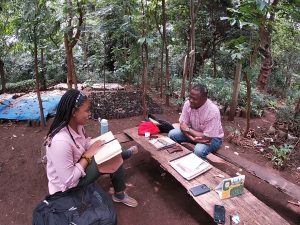
Jessica Bell with Samweli, a local forester, in Moshi, Tanzania
Uses for Mpingo in Tanzania
Mpingo is integrated into Tanzanian society in multiple ways. It is used as food for grazing game from elephants to giraffes. For rural communities, “the roots are used to treat abdominal pain, hernia, intestinal parasites, gonorrhea, headache, rhinitis, and bronchitis. The bark is used as an antidiarrheic or antibacterial. The leaves may treat throat inflammations, fever, syphilis, gonorrhea, and dysentery.”21 These medicinal practices are rare to find in big cities like Dar es Salam and Kilimanjaro, but in rural regions like Lindi and Kilwa, 90% of the population depends on local forests for survival.22
In 2019, I had the privilege of joining Daraja Music Initiative (DMI) on a journey to Tanzania, a transformative experience that clarified the intricate relationship between music, conservation, and the mpingo tree. The DMI mission is explained as follows:
Daraja Music Initiative (DMI) is an interdisciplinary program that bridges music education and conservation education. By providing an approach to sustainability through music education, DMI promotes conservation of the mpingo tree (commonly referred to as African blackwood or grenadilla), by actively engaging students and the community with the power of music.23
During my time in Moshi, Tanzania, I conducted interviews with locals, delving into the impact of mpingo on both the environment and cultural heritage. One notable encounter was with Samweli, a local forester, who provided insights into the challenges faced by the diminishing mpingo population. The gravity of the situation became even more apparent when I spoke with Bajojo, a seasoned Makonde carver with over two decades of experience. Bajojo shared the rich history of carving, traditionally passed down through generations in his family. Witnessing a decline in this skill, he took it upon himself to teach the younger generation in his community, emphasizing the importance of sustainable practices.
When asked about the significance of mpingo in his work, Bajojo revealed a shift in perspective—he now not only harvests the wood but also actively participates in replanting efforts. Reflecting on the dwindling availability of mpingo, he emphasized the need for using alternative trees and raising awareness about the challenges faced by mpingo to both Western audiences and East Africans. Bajojo commended the efforts of DMI and called for more programs to educate consumers in the Western world about the importance of responsible sourcing.
For Bajojo, carving is not merely a craft but a crucial part of his family and community identity. In Tanzania, where mpingo holds the status of the national tree, carving is intricately woven into the cultural fabric and economy. Bajojo’s sentiments underscore the vital role of Makonde carving in preserving a connection between art, culture, history, and identity. This narrative serves as a testament to the enduring power of art to bridge the past, present, and future, offering stories essential for understanding the Makonde people’s place in history and the contemporary world.
Makonde Carvers and Mpingo
As outlined in the African Blackwood Conservation Project’s publication “Makonde Art: Wood Carving Artists of Eastern Africa,” Makonde carvers, known for their masterful work with materials like mpingo, originated in Mozambique, where they formed the Makonde tribe while escaping Arab slave rule and tribal domination.24 Settling on high plateaus along the Ruvuma River, they maintained isolation from slave traders, concealing their villages in the forest to preserve their culture. Despite facing the harsh impact of European colonial powers in the 1800s, particularly Portugal, the Makonde carving tradition endured. Mozambican Makonde, seeking to evade Portuguese rule and taxation, migrated north to Tanzania, where their seasoned carvers utilized their talent to avoid strenuous labor.25 While nuances in practice differed between Tanzanian and Mozambican Makonde, both societies maintained matrilineal lineage, while carving traditions were sustained and passed down by the men. The tradition evolved from a tribal practice to a global artistic influence, impacting well-known artists like Picasso.26 By the 1950s, Makonde carvers began crafting African sculptures for foreigners, providing a source of income that continues to sustain local communities. The legacy of Makonde carving endures as a vital source of income for those, like Bajojo, who are dependent on this rich artistic tradition.
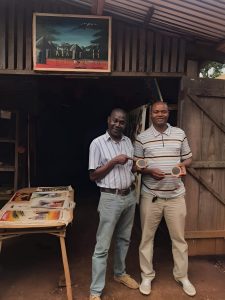
Bajojo (left) and Kimwela (right), artists and Makonde carvers in Moshi, Tanzania, holding drink coasters made from slabs of mpingo tree trunks
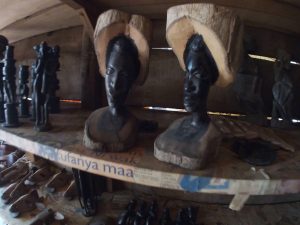
Carvings using the mpingo heartwood
Sustainable Solutions
To address the challenges facing Dalbergia melanoxylon (mpingo), potential solutions include collaboration between governments, industry stakeholders, and civil organizations; implementing certifications and traceability to ensure that mpingo is ethically sourced; enforcing labor laws; community development; and embracing alternative materials for clarinet manufacture. According to Dr. Washa B. Washa, propagation and conservation research started in Tanzania in the mid-1980s. The main contributing threats were overharvesting, difficulty germinating, and low seedling growth rate.27 Many organizations began forming, including the African Blackwood Conservation Project (ABCP), founded in 1996 by James Harris, an ornamental woodworker from Texas, USA, and Sebastian Chuwa, a botanist from Tanzania. Many of these organizations’ focus was towards propagation, replanting, and community involvement.
Organizations like Daraja Music Initiative and Mpingo Conservation & Development Initiative have been strategically curated to raise awareness and improve community involvement in Tanzania. These organizations provide education to local communities and present opportunities to communities worldwide to volunteer and learn about mpingo in a hands-on way. Their efforts also directly and indirectly mitigate pressures to cut down mpingo through replanting, pruning, forest certifications, etc.
While education efforts in Tanzania have been a strong focal point, efforts to enlighten Western musicians about the problems faced with mpingo harvesting should be pursued. Many clarinetists, aren’t aware of where their instrument comes from, much less whether it is ethically or sustainably sourced. One thing that we can do as clarinetists and music teachers is to teach our students about the problems, solutions, and innovations relating to clarinet materials. Having this information not only promotes awareness for mpingo conservation, but also great appreciation for the instrument and the people behind it.
Promoting ethical and sustainable harvesting practices on the part of local communities/governments, clarinet manufacturers, and conservation organizations can play a pivotal role in forest management, working conditions, and ethical sourcing. International agreements and certifications, such as the Convention on International Trade in Endangered Species (CITES) and Forest Stewardship Council (FSC) certification, can also contribute to the conservation and responsible trade of mpingo wood.
The push towards alternative materials, and advancements in composite materials and bioengineered materials, present opportunities for tailoring acoustical properties. These materials offer a balance of structural stability, customizable density, and enhanced acoustical control while mitigating pressures to harvest mpingo. Various synthetic materials, including hard rubber, resin composites, and plastics, have been developed as alternatives to traditional wood. Most notable of these is the Greenline clarinet created by Buffet Crampon. This is a patented material that combines wood shavings and carbon fiber to create stable clarinets with qualities resembling mpingo. These materials can provide consistent acoustical properties, durability, and resistance to environmental changes, and can make way for craftsmanship to shine. If all student- and intermediate-model clarinets were made from alternative materials, manufacturers could significantly decrease the demand for mpingo for clarinet making.
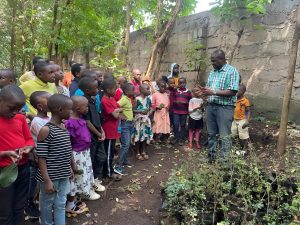
Samweli, the conservationist with Kiviwama Tree Nursery, talking to students at Majengo Primary
School and Kilimahewa Modern Secondary School
Conclusion
Mpingo, beyond its musical significance, stands as a crucial species with ecological importance. This paper recognizes the complexities of this species and the communities reliant on it. The aim is to cultivate sustainable practices that safeguard mpingo amidst demand and habitat pressures. Exploring the acoustical properties of clarinets and the impact of material selection on sound highlights the opportunity to explore alternative materials that can foster innovative solutions that reduce reliance on mpingo. This pursuit aligns with a commitment to both environmental sustainability, and the preservation of the clarinet’s tonal qualities and playability. In reframing the narrative around mpingo, we not only unveil its ecological significance but also spotlight the resilient communities intertwined with the tree, fostering a bridge between its historical legacy and its vital role in the clarinet community.
For more about the Daraja Music Initiative, see “Clarinets for Conservation: Sustaining the Earth Through Music,” by Katherine Palmer and Michele Von Haugg, in The Clarinet 45 no. 2 (March 2018).
Endnotes
1 A.B. Cunningham, “More than a Music Tree: 4400 Years of Dalbergia melanoxylon Trade in Africa,” South African Journal of Botany 98 (2015): doi:10.1016/j.sajb.2015.03.004.
2 Eliot Bates, “The Social Life of Musical Instruments,” Ethnomusicology 56 no. 3 (September 1, 2012): 363–95. https://doi.org/10.5406/ethnomusicology.56.3.0363.
3 U. G. Wegst, “Wood for Sound,” American Journal of Botany 93, no. 10 (2006): p.1443, doi:10.3732/ajb.93.10.1439.
4 Wegst, “Wood for Sound,” p.1441.
5 Albert R. Rice, The Baroque Clarinet and Chalumeau, 2nd ed. (New York: Oxford University Press, 2020), 90, 223-229.
6 L.J.V. Bevan, P.J. Harrison, J. Doubleday, J. Timothy, J. Lesikari, and A. Nicco, “The Mpingo Conservation Project Tanzanian Mpingo 99,” Mpingo 99 Full Report, Mpingo Conservation Project, 2003.
7 Anastasiia Y Glagoleva, Olesya Y. Shoeva, and Elena K. Khlestkina, “Melanin Pigment in Plants: Current Knowledge and Future Perspectives,” Frontiers in Plant Science 11 (June 23, 2020): https://doi.org/10.3389/fpls.2020.00770.
8 M. Jenkins, S. Oldfield, and T. Aylett, International Trade in African Blackwood. Fauna & Flora International,(Cambridge, UK: 2002).
9 K. Nakia et al., “Environmental factors and wood qualities of African blackwood, Dalbergia melanoxylon, in Tanzanian Miombo natural forest,” Journal of Wood Science 65, 1(2019): 10.1186/s10086-019-1818-0
10 L.J.V. Bevan, et al., “The Mpingo Conservation Project.”
11 Paul Harrrison, “A summary of the supply chain for African blackwood, market economics and opportunities for community forest certification with the support of the Mpingo Conservation Project and Kilimanyika,” Environment Africa Trust, UK, 2008.
12 “Mpingo- The Tree of Music.” YouTube. Accessed May 2, 2023. https://youtu.be/wUcW1dRH2XQ?si=4Y4kk34nAt4xSZwr.
13 Steve Ball, “Report of the Mpingo Survey 2000 Expedition,” the Mpingo Conservation Project, 2004.
14 Bette Stockbauer-Harris, “5,000 Year History – African Blackwood Conservation Project.” Accessed November 2, 2023. https://www.blackwoodconservation.org/5000-year-history/.
15 Ibid.
16 Ibid.
17 Alex Donovan, “Ivory Cutting: The Rise and Decline of a Connecticut Industry,” Connecticut History: A CTHumanities Project, Accessed October 25, 2023. https://connecticuthistory.org/ivory-cutting-the-rise-and-decline-of-a-connecticut-industry/.
18 Don Malcarne, Edith De Forest, and Robbi Storms, Deep River and Ivoryton, Arcadia Publishing, 2002.
19 Ibid.
20 Robert Storms and Don Maclarne, Around Essex: Elephants And River Gods (Charleston, South Carolina, Arcadia Publishing, 2001).
21 Kelly Paxton, African Blackwood Conservation Project, 2008, https://www.herbalgram.org/resources/herbalgram/issues/80/table-of-contents/article3328/.
22 M. Miya et al., “Drivers of Deforestation and Forest Degradation in Kilwa District,” Mpingo Conservation & Development Initiative, 2012.
23 Daraja Music Initiative, “About,” n.d, www.darajamusicinitiative.org.
24 African Blackwood Conservation Project, “Makonde Art,” n.d. https://www.blackwoodconservation.org/makonde-art/.
25 Ibid.
26 Ibid.
27 Dr Washa B. Washa, “A Review of the Literature of Dalbergia Melanoxylon,” International Journal of Plant and Forestry Sciences 1, no. 1 (January 2014): 1–6. www.ijpfs.com/.
Comments are closed.